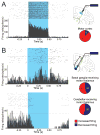Advances in optogenetic and chemogenetic methods to study brain circuits in non-human primates
- PMID: 28238201
- PMCID: PMC5572535
- DOI: 10.1007/s00702-017-1697-8
Advances in optogenetic and chemogenetic methods to study brain circuits in non-human primates
Abstract
Over the last 10 years, the use of opto- and chemogenetics to modulate neuronal activity in research applications has increased exponentially. Both techniques involve the genetic delivery of artificial proteins (opsins or engineered receptors) that are expressed on a selective population of neurons. The firing of these neurons can then be manipulated using light sources (for opsins) or by systemic administration of exogenous compounds (for chemogenetic receptors). Opto- and chemogenetic tools have enabled many important advances in basal ganglia research in rodent models, yet these techniques have faced a slow progress in non-human primate (NHP) research. In this review, we present a summary of the current state of these techniques in NHP research and outline some of the main challenges associated with the use of these genetic-based approaches in monkeys. We also explore cutting-edge developments that will facilitate the use of opto- and chemogenetics in NHPs, and help advance our understanding of basal ganglia circuits in normal and pathological conditions.
Keywords: Basal ganglia; Chemogenetics; DREADDs; Monkeys; Non-human primates; Opsins; Optogenetics.
Figures


References
-
- Albin RL, Young AB, Penney JB. The functional anatomy of basal ganglia disorders. Trends Neurosci. 1989;12:366–375. - PubMed
Publication types
MeSH terms
Grants and funding
LinkOut - more resources
Full Text Sources
Other Literature Sources

